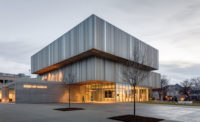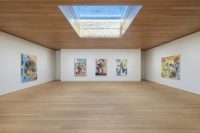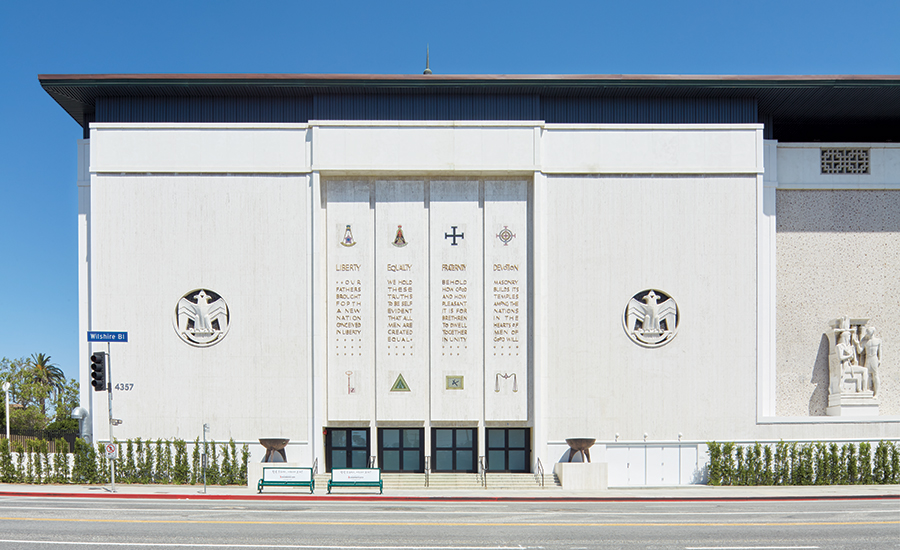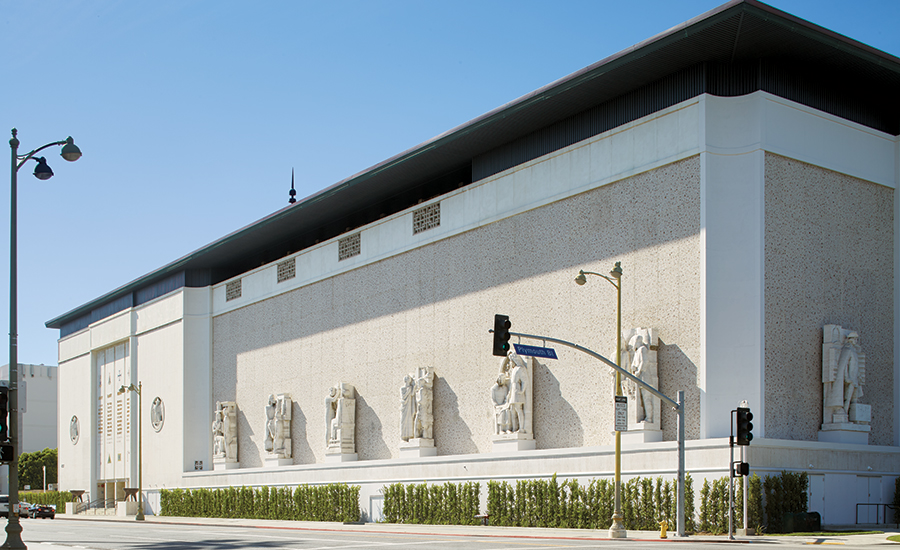Marciano Art Foundation by wHY
Los Angeles

The limestone facade features enigmatic Masonic symbols and heroic statues.
Photo © Yoshihiro Makino

The limestone facade features enigmatic Masonic symbols and heroic statues.
Photo © Yoshihiro Makino

The lobby, clad in travertine, doubles as an exhibition space.
Photo courtesy Marciano Foundation / wHY

The building's ornamentation includes a large exterior mosaic.
Photo © James Ewing / Otto

On the upper level, the dining hall’s cathedral ceiling has been opened to its rafters, with long fluorescent bulbs punctuating the rhythm of girders.
Photo courtesy Marciano Arts Foundation / wHY

The ghosts of the raked seating are visible in the trussed former theater.
Photo © Yoshihiro Makino

An original embellishment glows in a conference room.
Photo © Yoshihiro Makino

Image courtesy wHY Architecture

Image courtesy wHY Architecture









Architects & Firms
Masonic temples tend be curious buildings—largely windowless and laced with cryptic symbols—and the one on Wilshire Boulevard, in Los Angeles, is no exception. Monumental and blocky, with heroic statues along its facade, the Scottish Rite Masonic Temple has always had an imposing yet enigmatic presence, punctuated by ciphers, such as an eye, a spear-skewered heart, and drafting compasses, across its travertine shell. For all its grandeur, however, the secretive 110,000-square-foot building languished vacant for years. But this onetime palace of ritual has recently come back to life as the Marciano Art Foundation (MAF)—a repurposing by the design firm wHY that simultaneously lays bare, embraces, and transcends the venue’s abundant idiosyncrasies.
In 1961, when artist-designer Millard Sheets completed the building, the Scottish Rite fraternal order had soaring ambitions for it, incorporating such amenities as a banquet hall for 1,500 and a 2,200-seat, full-fly, raked theater, where the brotherhood staged elaborate initiation dramas. Sheets was known for his Midcentury Modern branch banks across Southern California. And the temple’s mystical ornamentation included his huge interior and exterior mosaics. But by 1994, dwindling membership forced the Masons to vacate. The building became an occasional venue for raves, boxing matches, and sundry other uses before the city shut it down. Fortunately, in 2013, Paul and Maurice Marciano, two cofounders of the Guess company—famous for its sassy ads and provocatively tight jeans—purchased the property and transformed the eccentric shrine into their own museum to publicly display their extensive collection of contemporary art and planned site-specific commissions.
Additional Content:
Jump to credits & specifications
Beyond such architectural flourishes as elevator doors emblazoned with bronze compasses, the Masons had left behind a trove of ritual paraphernalia, including stage sets, costumes, wigs, tasseled fezzes, and dioramas. To display such relics without upstaging the contemporary art, wHY converted the former library into a separate exhibition room, preserving its dark wood cabinetry and double-headedeagle stained glass.
By contrast, the main galleries—extending through the former theater and banquet hall—have an industrial edge. The 13,400-square-foot auditorium, now stageless, is dramatically warehouse-like, with a high trussed ceiling, concrete floors, and ghosts of the raked seating and balcony visible only in exposed structural traces across the concrete side walls. Upstairs, the dining hall’s cathedral ceiling has been opened to its rafters, with long fluorescent bulbs punctuating the rhythm of girders.
MAF’s many vintage elements include wall-embedded water fountains of polished brass or lined in small, wheat-colored tesserae sparked with occasional gilded tiles. The lobby, which doubles as exhibition space, bears Sheets’s dynamic, vertically streaked travertine wall panels, inset with lines of gold, jewel-like tiles embossed with mysterious glyphs. Overhead are restored pendant lamps, their quasi-sacred bowls ringed by Masonic symbols.
But most dazzling is the banquet hall’s formerly focal “altarpiece,” a tall Sheets mosaic with raccoons, foxes, and peacocks frolicking amid polychromatic cypresses. To keep its fauna and flora from competing with the contemporary art, however, wHY inserted a partition in front of the mural, separating it from the main gallery space. While evoking a private chapel, the wall stands so close to the mural that viewers can’t back up to take in the whole composition. But the partitions elsewhere in the banquet hall are more successful, positioned to control daylight and views while taking advantage of a panoramic band of windows (the onetime dining area has the temple’s only fenestration).
The dialogue between Masonic and contemporary permeates the building. And artists are invited to integrate select temple artifacts into new works here. (For MAF’s inaugural show, which opened on May 25th, artist Jim Shaw incorporated a vision-of-hell theatrical backdrop into one piece, and leftover wigs into another.)
It’s oddly fitting that Guess, a company whose name plays on the role of symbols (albeit fashion ones), is associated with this repository of obscure motifs. Certainly wHY embraced that pairing, meshing old and new with such nimbleness that the facade’s boldface “G” could pass for a reference to Guess’s single-letter sub-brand, instead of yet another Masonic cipher.
CreditsArchitect: wHY Los Angeles
Personnel in architect's firm who should receive special credit: Kulapat Yantrasast – Creative Director and Lead Designer
Architect of record: Michael Gruber, AIA
Interior designer: wHY
Engineers Structural: Kurt Fischer Structural Engineering
Consultants Lighting: Horton Lees Brogden Lighting Design
General contractor: Turner Construction Company
Photographer: Yoshihiro Makino
|
SpecificationsStructural System Reinforced concrete shear wall structure Manufacturer of any structural components unique to this project: Plas-Tal Steel Construction Windows Metal frame: C.R. Laurence Co., Inc. Doors Entrances: C.R. Laurence Co., Inc. Metal doors: Door components Inc. Sliding doors: Western Window Systems Hardware Locksets: Corbin Russwin, McKinney, Rixson, Rockwood, Sargent, Trimco Closers: Norton Door controls Exit devices: C.R. Laurence Co., Inc. Pulls: C.R. Laurence Co., Inc. Security devices: Sentrol, Zero Interior Finishes Acoustical ceilings: Armstrong Suspension grid: Armstrong Demountable partitions: Thrislington Cubicles Ltd Cabinetwork and custom woodwork: Wavell Huber Wood Products, Inc. Paints and stains: Benjamin Moore Sherwin-Williams Dunn-Edwards Wolf Gordon Paneling: Alucobond Floor and wall tile: Restroom floors & walls: Stone Source Carpet: Monarch Carpet Furnishings Office furniture: Knoll Fantoni Halcon Fixed seating: Martin Brattrud Chairs: Arper Coalesse Tables: Halcon Knoll Watson Arper Upholstery: Maharam Other furniture: Knoll Workstation Lighting Interior ambient lighting: Prudential Lighting, Lighting Services Inc. Downlights: Amerlux Exterior: BK Lighting Dimming system or other lighting controls: Lutron Electrics, Inc. Conveyance Elevators/escalators: Mitsubishi Plumbing Duravit, Kohler, Toto, Speakman
|















